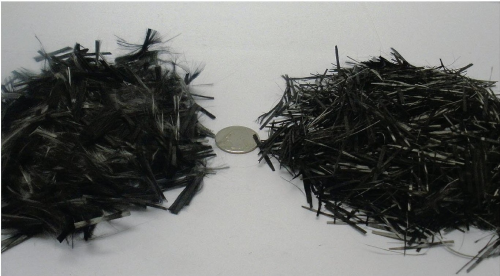
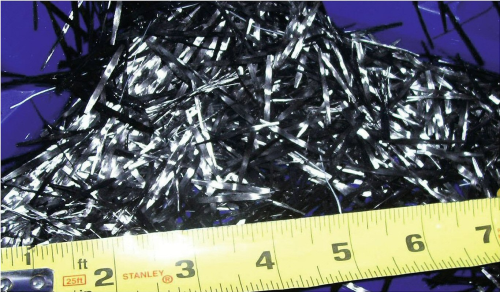
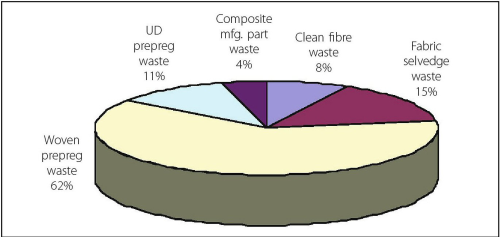

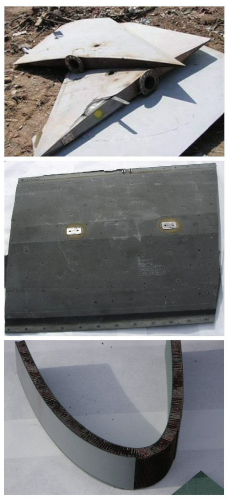
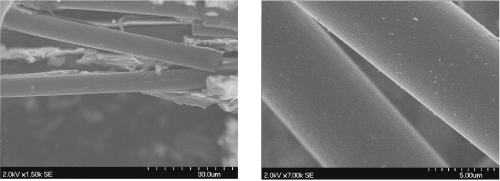
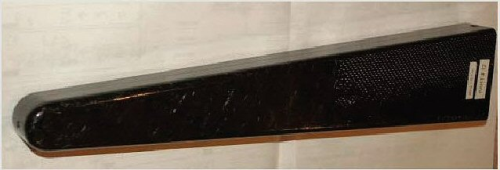
With an estimated 3000 tonnes (6.6 million lbs) of carbon fibre composite (CFRP) scrap (so-called ‘black junk’) being generated annually in the USA and Europe, some 6000 to 8000 commercial planes expected to reach end-of-life dismantlement by 2030, and the production of virgin carbon fibre (VCF) on the rise toward 100 000-plus tonnes (220 million lbs) annually by 2018, something’s gotta give. Where will all this black junk go?
Neither landfill nor incineration disposal of CFRP scrap is optimal, and environmental regulations may eventually lead to a ban on both. Enter the paradigm of penultimate asset management, the potential for wringing revenues even beyond the aircraft boneyard by recycling the high-grade carbon fibre components onboard. Companies large and small seek to glean this gold through enhanced eco-friendly or ‘green’ processes. However, development of a CFRP recycling industry is in its infancy, and processes to date are expensive and complicated mainly because high-performance engineered materials are, well, well engineered. To the point that CFRP in one of the newest commercial passenger aircraft, Boeing’s 787, that a source for this article deems them downright intractable.
Intractable by design
“Intractable by design, therefore significantly challenging to recycle,” is Jan-Michael Gosau’s assessment of the technological task of reclaiming carbon fibres from epoxy-predominant CFRP because the continuous reinforcement is chemically well bonded to the crosslinked matrix resin.
Gosau is Environmental and Energy Programs Manager for research company, Adherent Technologies Inc (ATI) based in Albuquerque, New Mexico USA. The company has worked on recycling processes since 1995, with $3 million (€2 million) in funding along the way from the US Departments of Defense and Energy and an alliance with Titan Technologies. Titan is an Albuquerque developer of a pyrolysis process for recycling automobile tyres.
“In the mid-1990s,” Gosau indicates, “we ran the gauntlet with pyrolysis, trying to hit just the right temperature/oxygen content sweet spot, and decided it was not optimal for CFRP recycling as our primary process.”
ATI has evolved a catalytic conversion technology centered around its batch-based carbon fibre recyclate processing, combining three different processes studied over the past decade, each with specific advantages and limitations.
Vacuum pyrolysis, a dry process operated at around 500°C (932°F), recovers resins as marketable liquids and can be easily scaled up to multi-tonne capacity. At this temperature, however, fibre product may retain oxidation residue or char.
The company’s low-temperature liquid process operates at 150°C (302°F), runs at less than 150 psi on standard equipment, and produces a market-ready fibre, but is not particularly tolerant of scrap contaminants (such as metal, wire, paint and sealants). The high temperature liquid option (around 300°C/572°F) produces clean fibres from most composites, but requires customised equipment and is currently not considered necessary for commercial recyclate production. Phenol has proven a good choice as initial heat transfer fluid for both wet processes; the breakdown products of the resin can be recycled into glue for the production of plywood.
ATI has demonstrated its low-temperature wet process in combination with vacuum pyrolysis for the removal of insoluble contaminants in a pilot-scale reactor capable of processing 23 kg (50 lbs) an hour.
Gosau adds that testing of its recycling technology on CFRP scrap with multiple resin chemistries indicates that the combination of dry and wet processes is the best way to maximise recyclate quality. Low temperature wet chemical processing removes the bulk of the resin and some contaminants, followed by thermal post-treatment through vacuum pyrolysis to eliminate remaining resin and produce 99% fibre purity.
“This may not result in the most elegant processing,” Gosau concludes, “but we can handle the true mixed soup of CFRP waste without the need for time-consuming and expensive hand sorting, making it financially viable. Further, the combined approach eliminates the need for any solvent use.”
ATI’s recycling technology used this combined approach to recycle scrap from test articles built within the Boeing 787 Dreamliner programme. The thick laminate structure, which utilises a thermoplastic toughener in an interlayer between the carbon fibre/epoxy layers, presented near intractability in terms of recyclability. Application of ATI’s low temperature wet process completely dissolved the epoxy but left the toughener behind. Next, vacuum pyrolysis at 525°C (977°F) removed the toughener and other contaminants.
Boeing's support of ATI’s small business effort in developing recycling technology leaves no doubt of the OEM’s eco-responsible proactivity. The new B787 is 50% composites by weight and predominantly carbon fibre laminate and carbon fibre skins over core in sandwich structure.
For any company involved in the development of the CFRP recycling industry, there is a performance perception problem to be dealt with. This is the idea that recycled carbon fibres are of secondary or “lesser than” quality than VCF. While recyclate properties vary, leading R&D indicates that properties reduction of only 3-5% compared to VCF has been exhibited in reclaimed chopped and milled fibres used to make thermoplastic compounds such as bulk moulding compound (BMC).
Even when recyclate with performance properties comparable to VCF, evolving the business of CFRP recycling involves formidable requirements. Gosau lists those as “consistent scrap availability, appropriate size reduction technologies for the CFRP waste, established process parameters, the infrastructure for secondary operations such as material collection at a manufacturer’s site, and eventually, creation of standardised recyclate product properties.” Currently, ATI’s recycling technology solutions await licensees or possible turnkey operations partners, though Gosau verifies them as “robust and definitely commercially viable for proceeding to next-level production at 1000 tonnes/annum.” Further, at the suggested price of US$5/lb for recyclate, the company believes a reasonable profit can be made.
Zapping CFRP with microwaves
Microwave pyrolysis is another form of CFRP recycling under development by companies and universities in the USA, UK and Germany. Generally, microwave energy absorbed by the conductive properties of carbon fibre heat the matrix resin internally rather than externally. The can result in more rapid resin decomposition and recovery of fibres without char formation, shorter overall processing time, and smaller scale equipment than is required for other pyrolysis methods. Over the past three years, research company Firebird Advanced Materials Inc in Raleigh, North Carolina, USA, has built a small pilot-scale installation to test its microwave recycling process, and this year, has begun implementation of commercialisation plans.
Funded primarily by a US Air Force/National Science Foundation Small Business grants in the order of $1 million (€738 000) (and collaborating with North Carolina State University), Firebird has demonstrated the world’s first continuous microwave CFRP recycling process with its equipment, reports Thomas Hunter, company president. He estimates that about 50% of CFRP manufacturing waste comes from woven prepreg generated during pattern cutting. This fabric waste can arrive at a recycler in forms ranging from a fresh, tacky entangled material to a hard, compressed bale of overaged and cured scrap.
To convert this extreme range of feedstock into a commercial product, Hunter and business partner Chuck Segal believe it is crucial to develop cooperative relationships between waste generator and waste recycler. The best setup to foster this, Hunter suggests, will come in a network of smaller-scale facilities near a sufficient feedstock supply.
“You can’t just let a generator fill a waste bin with scrap and expect that it will be economical to recycle,” he says. “Your relationship with feedstock generators is essential in providing information about the feedstock in terms of the total material chemistry and fibre content, maybe even access to raw material certifications that will allow a higher market price for the recycled fibre.”
Hunter points out that the quality of the CFRP waste affects labour costs dramatically, especially for hand sorting.
“Assuming $10/hour labour for hand sorting 10 kg per hour of prepreg scrap with release film, for example, one could end up spending $2/kg for this function alone, which is a good chunk of change when recyclate is priced at only $5/lb, or perhaps even at $20/kg for high quality recyclate.”
He touts the efforts of the Aircraft Fleet Recycling Association (AFRA) in helping foster scrap generator/CFRP recycler cooperation toward the growth of the recycling industry.
First commercial CFRP recyclate line
Speaking of world firsts, the first continuous pyrolysis recycling line producing commercial carbon fibre recyclate is in operation by Recycled Carbon Fibre Ltd (RCF) of West Midlands, UK. The company morphed out of technology developed by research company Milled Carbon Ltd, and began commercial operations in October 2008. Steve Line, CEO, explains that the two companies are entirely separate entities now, but characterises the nature of their connection as “brilliant concepts require equal brilliance to get to commercial operations.”
Aircraft OEMs play a critical role in making CFRP recycling viable, as do government agencies, industry organisations, and universities in enhancing R&D and project cost sharing. Leading ongoing recycling technology and demonstration programs underway internationally are briefly described below. Aircraft Fleet Recycling Association/AFRA (Washington, DC, USA)Founded in 2005, AFRA now has 41 members within the aircraft industry, all committed to applying their 100 years of combined aircraft recycling expertise to aircraft scrapping with best technical standards. The organisation has developed both printed Best Management Practices guides and an accreditation path for more effective, safe and green aircraft dismantlement, parts recovery, and materials recycling. AFRA member companies in 10 different countries currently scrap an estimated 30% of the world’s end-of-life fleet aircraft. The Boeing Co (Chicago, Illinois, USA)A founding member of AFRA, original equipment manufacturer (OEM) Boeing aims to boost the amount of recycled aircraft material from 70% today to 90% by 2016. The company began CFRP recycling from retired F-18A military planes in 2005, carried this through 777 composite components and even used 787 pre-production scrap from a fuselage test article to prototype a seat arm rest and composite lay-up tool. William Carberry, Project Manager of Airplane and Composite Recycling for Boeing Commercial Airplanes and the Deputy Director of AFRA, adds that Boeing is also testing other parts made from carbon fibre recyclate. He notes that “the pending legislation in Europe to ban landfill disposal of composites will have significant impact in the next 3-5 years. Companies in the airplane maintenance and end-of-service business sectors (especially in Europe and Japan) are going to need an alternative disposal method, and we hope the carbon fibre recycling industry will be strong enough by then to offer that option.” Among AFRA members that Boeing has worked with directly in developing CFRP recycling technologies are Milled Carbon/Recycled Carbon Fibre, Adherent Technologies, and the University of Nottingham. Airbus Industries (Toulousse, France)As part of the European Commission’s LIFE programme, OEM Airbus initiated the Process for Advanced Management of End-of-Life Aircraft or PAMELA project in 2005 with five other partners. The group’s goal: enhance the eco-efficiency of new aircraft so that 85-95% of components and materials could be recycled, reused or recovered, and to establish new standards for green management in the disposal of end-of-life aircraft. Proof of such green processes in garnering the gold of added revenue from the black junk off a decommissioned A300-B4 aircraft occurred in 2006 at Tarbes Airport in Southern France. This included recycling potential for the 4% by weight of composite materials on the A-300). In 2008, experience from this effort materialised into TARMAC Aerosave (Tarbes Advanced Recycling and Maintenance Aircraft Company), a joint venture company set up to take the eco-friendly PAMELA-LIFE aircraft deconstruction and recycling technologies to the industrial level. The 97 000 ft2 facility includes a hangar that can house an A380, the OEM’s largest passenger aircraft to date, and Airbus has recycled parts from an A380 static test airframe through the facility. In a separate consortia effort, Airbus is working with CFK-Valley Stade Recycling GmbH & Co KG of Stade, Germany to develop a 1000 tonne/year pyrolysis-based recycling plant for the recovery of carbon fibres from both CFRP manufacturing scrap and decommissioned Airbus aircraft. Dow Deutschland Anlagengesellschaft mbH Stade is CFK’s engineering partner, and target launch for the plant opening is this October. Tim Rademacker, head of CFK’s Sales and Marketing, states that pilot plant recyclate grades exhibit ultraclean surface properties (no resin or char) and have been trialed in filled thermoplastic compounds. University of Nottingham (UK)The University of Nottingham has a decade worth of R&D into carbon fibre recycling, particularly in the fluidised bed process and more recently, involving supercritical fluids such as propanol. Researchers have created nonwoven mats with CFRP recyclate as are developing a convergent flow slurry process to enhance fibre alignment and achieve higher fibre volumes. The university has also participated in the automotive-focused HIRECAR (High Value Composite Materials from Recycled Carbon Fibre) project (2005-2008) and is now involved, with partners, in the follow-on AFRECAR (Affordable Recycled Carbon Fibres) project with technology and application research inclusive of both automotive and aerospace industries. Dr Steve Pickering, Associate Professor in the Department of Mechanical, Materials and Manufacturing Engineering, reports that “current research to develop alignment techniques for carbon fibre will allow it to be used in higher value applications such as non-critical aerospace components where the properties of other materials can’t compete. In the current AFRECAR project, we hope to build demonstrator components in 2011.” He adds that the university’s research in fluidised bed recycling has demonstrated the process “as inherently simple and ideally suited to end-of-life material since it is tolerant of contamination.” |
The demonstration project originally launched by Milled Carbon to prove its process research was about a fourth the size of the current 60 000 ft2 RCF facility, with current capacity for recycling CFRP scrap at 1200 tonnes (2.6 million lbs) of recyclate per year. The pyrolytic furnace reclaims fibres at 500-900°C (932-1652°F) and is 30 m (100 ft) in length and 9 m (8 ft) wide. Line says incoming scrap must be assessed and separated if metals are present in the CFRP because “not all waste is lovingly cared for.” The UK plant has received a highest-level environmental permit for its operations, which features an extensive abatement system to clean the fumes created by resin decomposition.RCF’s carbon fibre recyclate is clean, with no char, and retains 90% or higher properties compared to VCF, Line reports.
“In some cases, surface properties of the recyclate are actually enhanced over VCF.”
Product forms include chopped, milled and pelletised fibres. In addition to applications for CFRP recyclate previously mentioned here, Line lists antistatic flooring, industrial paints, cement and road surfacing, EMI shielding, industrial coatings, flotation devices, wooden or metal frames, high temperature insulation, rubber reinforcement and tooling moulds.
Line’s enthusiasm for RCF’s recycling technology and facility isn’t stifled by the enormity of the challenge finding volume markets for the recyclate.
“As we see it, there are two distinct end uses for CFRP recyclate: in products where it replaces VCF and in products using recyclate as a completely new and ‘green’ material,” he says. “Considering that the market price and availability of VCF goes up and down like a fiddler’s elbow, and due to the influence of activity in the aerospace sector, we are looking to offer customers a fixed price and consistent quality and supply. Our hope is that pricing for recyclate can be a third to a half as much as VCF, which we believe is a compelling proposition.”
He is also cognisant of the very real risks involved in a new industry with uncertain supply volume of CFRP. Should feedstock scrap rates suddenly drop, recyclers lose the core of their businesses. In Line’s experience, however, “there are many large corporations who ‘walk the talk’ of eco wisdom and want to avoid dumping or burning composite waste.” He believes they should be rewarded for this consciousness and action: “Why not include them in carbon trading schemes based on the amount of waste they supply?”
RCF has announced plans to open a second recycling plant in the USA later this year, or in 2011.
Technology viability
Understandably, detail about specific process parameters and equipment design, recyclate properties and end-use customers, pricing and fibre lengths, and especially volumes of recyclate tested and sold remain in stealth mode to protect competitive advantage. This is clearly the case with YF International BV (YFI) of Duiven, The Netherlands, and partner company Apply Carbon, Languidic, France. The companies — YFI collecting the CFRP waste and Apply Carbon processing it — claim to have been selling multiple grades of commercial CFRP recyclate since 1998.
Klaas Hauwert, YFI’s Managing Director, won’t get into specifics about the pyrolysis-based process or the volume level being sold but does identify the niche markets for the company’s hundreds of tonnes/year of carbon fibre recyclate produced: filled thermoplastic compounds for BMC and thermoset compounds for sheet moulding compound (SMC). The company also recycles aramid, glass, nylon and polyester fibres.
Hauwert notes that the “lesser than VCF properties” perception of recyclate has been readily dissuaded within his customer base “simply by using our products and achieving the performance needed.” Feedstock for the company’s CFRP recycling comes from composite components as well as fabric waste, selvedges, filament waste, rest spools and bobbins (or skinners), though Hauwert notes that “we still find companies who throw away their precious carbon fibre scrap. This is a great pity since we need the carbon fibre and the waste generator could benefit by reducing disposal costs.”
With OEMs generating CFRP waste even as they build new and better aircraft and recyclers opening industrial capacity plants to handle the waste, the stage is set for achieving penultimate asset management by recycling composites even beyond an aircraft’s end-of-life dismantlement. How much additional revenue is something of a ‘best guess’ but Firebird’s Hunter gives it a go.
“We have a good idea what VCF production and growth rate will be, and historically, we know the percentage of CFRP scrap generated from end-of-life aircraft in the 1970s and 1980s, as well as the current number of end-of-life aircraft. We know that CFRP parts made today will be scrapped perhaps 30 years from now. What isn’t publicly known is the volume of manufacturing scrap generated today by carbon fibre and CFRP producers. If we assume about 20% of total carbon fibre made in the US, that translates to about 2000 tonnes (4.4 million lbs) of scrap a year. If recyclate has a marketable price of $5/lb, this translates to $20 million (€14.7 million) worth of material that could be rescued from landfills and turned into reclaimed fibre, with a potential value of $40 million (€29.5 million) by 2016" (assuming continued VCF production growth rate at 15% annually worldwide).
Hunter makes the further point that the automotive industry might be more embracing of chopped and milled carbon fibre if a stable, low cost raw material supply could be provided by recylate.
Two things seem certain: the composites industry will continue to optimise technology at every step of utilisation; and the key to the successful use of recyclate carbon fibre will rely upon appropriate use of the reclaimed material in products designed specifically for recyclate properties. Or as YFI’s Hauwert puts it, “by emphasising application, application, application.”
This feature was published in the March/April 2010 issue of Reinforced Plastics magazine.
